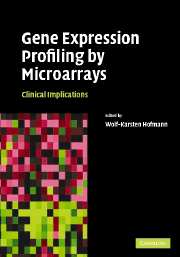Book contents
- Frontmatter
- Contents
- List of contributors
- Foreword
- Introduction
- 1 Technique of microarrays: microarray platforms
- 2 Quantitative quality control of microarray experiments: toward accurate gene expression measurements
- 3 Statistical analysis of gene expression data
- 4 Genomic stratification in patients with heart failure
- 5 Gene expression profiling for the diagnosis of acute leukemias
- 6 Gene expression profiling can distinguish tumor subclasses of breast carcinomas
- 7 Gene expression profiling in lymphoid malignancies
- 8 mRNA profiling of pancreatic beta-cells: investigating mechanisms of diabetes
- 9 Prediction of response and resistance to treatment by gene expression profiling
- Index
- References
3 - Statistical analysis of gene expression data
Published online by Cambridge University Press: 05 September 2009
- Frontmatter
- Contents
- List of contributors
- Foreword
- Introduction
- 1 Technique of microarrays: microarray platforms
- 2 Quantitative quality control of microarray experiments: toward accurate gene expression measurements
- 3 Statistical analysis of gene expression data
- 4 Genomic stratification in patients with heart failure
- 5 Gene expression profiling for the diagnosis of acute leukemias
- 6 Gene expression profiling can distinguish tumor subclasses of breast carcinomas
- 7 Gene expression profiling in lymphoid malignancies
- 8 mRNA profiling of pancreatic beta-cells: investigating mechanisms of diabetes
- 9 Prediction of response and resistance to treatment by gene expression profiling
- Index
- References
Summary
Abstract
Statistical analysis of the complex data sets produced in DNA microarray experiments presents substantial challenges to the experimenter and statistician alike. Due to the large number of genes and small number of samples, traditional statistical analysis methods alone are not typically sufficient to make appropriate conclusions. This chapter introduces the reader to the basic concepts in the analysis of microarray data and provides a summary of some of the most commonly used techniques. The overall structure of a microarray data analysis can be divided into four distinct components. The four components of a microarray data analysis consist of data preprocessing/quality control, identification of differentially expressed genes, unsupervised clustering/data visualization, and supervised classification/prediction. As the science of microarray analysis has advanced, a wide variety of methods have been developed to address each of these components. Guidance is provided as to the situations in which the various techniques can be applied most productively and cautions given about cases where these techniques will give inappropriate answers.
Introduction
The growth of microarray research has resulted in considerable interest in the statistical and computational communities in the development of methods for addressing these problems. The most common scientific questions asked in a microarray experiment are, “What genes are correlated with specific characteristics of the samples?” and “Are there specific patterns of gene expression, or combinations of multiple genes, which can accurately predict the sample characteristics?”
- Type
- Chapter
- Information
- Gene Expression Profiling by MicroarraysClinical Implications, pp. 47 - 79Publisher: Cambridge University PressPrint publication year: 2006



